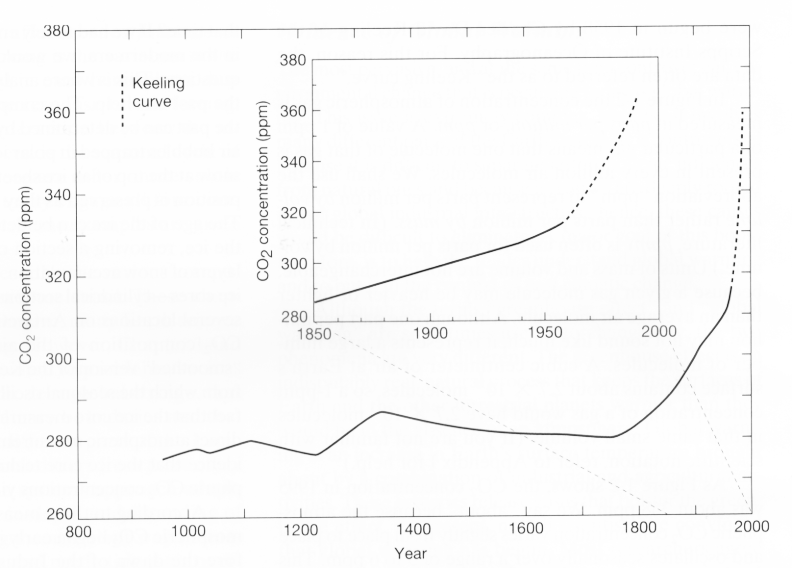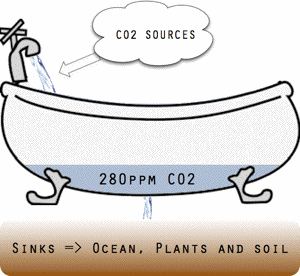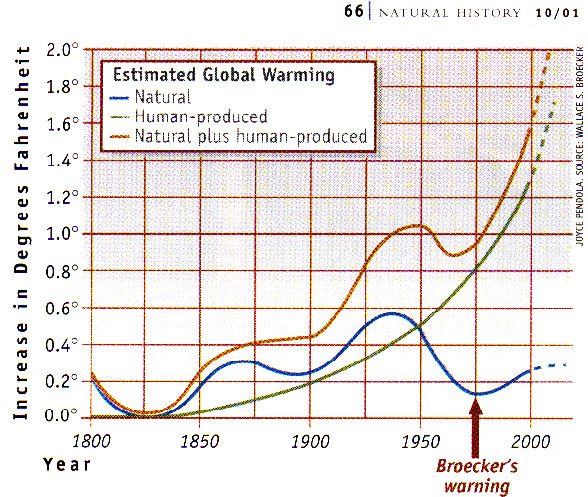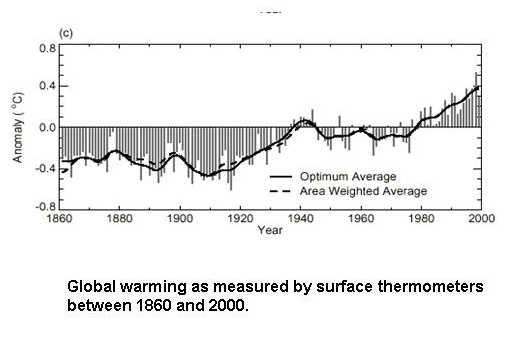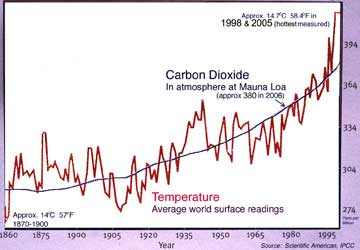Source of Abrupt Climate Changes
"Causes of Climate Change Over the Past 1000 Years."
Science 289, 270 (2000);
Thomas J. Crowley
DOI: 10.1126/science.289.5477.270
Pages 270-277.
"The number one source of carbon pollution that causes climate change and expensive, extreme weather is carbon pollution from coal-burning power plants." Will Steger Foundation.
"A Changing Climate," Fall, 2013, p. 6.
Abstract | Indicators | Conclusion | Graphs | Factors | National Security
Content abstract
Recent reconstructions of Northern Hemisphere temperatures and climate forcing over the past 1000 years allow the warming of the 20th century to be placed within a historical context and various mechanisms of climate change to be tested. Comparisons of observations with simulations from an energy balance climate model indicate that as much as 41 to 64% of pre-anthropogenic (pre-1850) decadal-scale temperature variations was due to changes in solar irradiance and volcanism. Removal of the forced response from reconstructed temperature time series yields residuals that show similar variability to those of control runs of coupled models, thereby lending support to the models’ value as estimates of low-frequency variability in the climate system.
Removal of all forcing except greenhouse gases from the 1000-year time series results in a residual with a very large late-20th-century warming that closely agrees with the response predicted from greenhouse gas forcing. The combination of a unique level of temperature increase in the late 20th century and improved constraints on the role of natural variability provides further evidence that the greenhouse effect has already established itself above the level of natural variability in the climate system. A 21st-century global warming projection far exceeds the natural variability of the past 1000 years and is greater than the best estimate of global temperature change for the last interglacial.
Conclusion:
"One way to highlight the unusual nature of the late-20th-century warmth is to subtract all forcing other than CO2 (solar, volcanism, and tropospheric aerosols) and examine the late-20th-century residuals within the context of the previous 1000 years (Fig. 6). There is an unprecedented residual warming in the late 20th century that matches the warming predicted by GHG forcing."
"There are therefore two independent lines of evidence pointing to 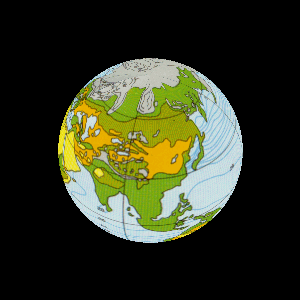 the unusual nature of late-20th-century temperatures. First, the warming over the past century is unprecedented in the past 1000 years. Second, the same climate model that can successfully explain much of the variability in Northern Hemisphere temperature over the interval 1000–1850 indicates that only about 25% of the 20th-century temperature increase can be attributed to natural variability. The bulk of the 20th-century warming is consistent with that predicted from GHG increases. These twin lines of evidence provide further support for the idea that the greenhouse effect is already here. This assertion may seem surprising to some because of continuing uncertainties with respect to the dynamical response of the ocean-atmosphere system and radiative forcing feedbacks (both direct and indirect) of, for example, clouds, biomass burning, and mineral dust. Although regional climate change is almost certainly influenced by these complex dynamic and thermodynamic feedbacks, the striking agreement seen in this study between simple model calculations and observations indicates that on the largest scale, temperature responds almost linearly to the estimated changes in radiative forcing. The very good agreement between models and data in the pre-anthropogenic interval also enhances confidence in the overall ability of climate models to simulate temperature variability on the largest scales."
the unusual nature of late-20th-century temperatures. First, the warming over the past century is unprecedented in the past 1000 years. Second, the same climate model that can successfully explain much of the variability in Northern Hemisphere temperature over the interval 1000–1850 indicates that only about 25% of the 20th-century temperature increase can be attributed to natural variability. The bulk of the 20th-century warming is consistent with that predicted from GHG increases. These twin lines of evidence provide further support for the idea that the greenhouse effect is already here. This assertion may seem surprising to some because of continuing uncertainties with respect to the dynamical response of the ocean-atmosphere system and radiative forcing feedbacks (both direct and indirect) of, for example, clouds, biomass burning, and mineral dust. Although regional climate change is almost certainly influenced by these complex dynamic and thermodynamic feedbacks, the striking agreement seen in this study between simple model calculations and observations indicates that on the largest scale, temperature responds almost linearly to the estimated changes in radiative forcing. The very good agreement between models and data in the pre-anthropogenic interval also enhances confidence in the overall ability of climate models to simulate temperature variability on the largest scales."
SCIENCE. VOL 289, 14 JULY 2000.
Green House Gas [GHG] increases
The National Security threat from Global Warming
The Pentagon & Climate Change: How Deniers Put National Security at Risk
"The leaders of our armed forces know what's coming next – but deniers in Congress are ignoring the warnings."
By Jeff Goodell, Rolling Stone, February 12, 2015
"What Locklear correctly foresees is that a world of climate-driven chaos is already upon us, and it's only going to get worse. And we need to start talking about it now, because not only will the threats multiply, so will the questions we have to address."
Read more:
http://www.rollingstone.com/politics/news/the-pentagon-climate-change-how-climate-deniers-put-national-security-at-risk-20150212#ixzz3VeXENzBk
"Immediate Risk to National Security Posed by Global Warming,"
"A new Pentagon report declares climate change to be a threat multiplier" Scientific American, October 14, 2014.
"The Pentagon released a landmark report yesterday declaring climate change an 'immediate risk' to national security and outlining how it intends to protect bases, prepare for humanitarian disasters and plan for global conflicts. The 20-page '2014 Climate Change Adaptation Roadmap' warns that rising sea levels could flood coastal military bases in the United States and around the world, while droughts and extreme weather could leave leave military training areas vulnerable, hinder the execution of amphibious landings or complicate surveillance and reconnaissance capability."
DOD, United States Department of Defense: 2014 Climate Change Adaptation Roadmap, October 13, 2014.
Abstract | Indicators | Conclusion | Graphs | Factors | Isotopic evidence
Archer | Christianson | Gelbspan | James Hansen, 04 : Hansen 06 | McKibben| Musil | Schmidt | Weart | Wigley
